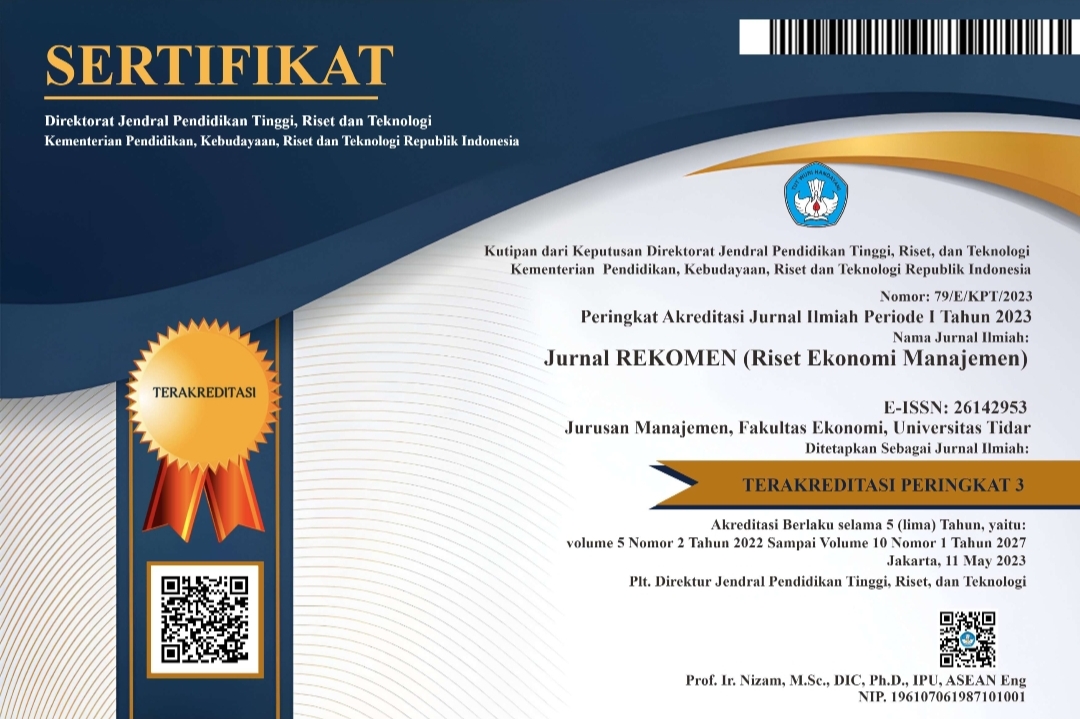Author Guidelines
Format guidelines can be downloaded here
Authors are required to upload a statement of originality as a supplementary file when submitting articles through OJS. The preparation of article manuscripts must follow the following author guidelines:
- Format
The manuscripts should be typed in A4 (210mm x 297mm), with 12-point Garamond font and must be 1.15 line-spaced. The manuscript must be saved as a word file. All the pages, including tables, appendices, and references, should be serially numbered. Authors are encouraged to use the Jurnal REKOMEN template. A sample template is included at the end of this document.
- Language
Start from Volume 5 Number 1, September 2021, the manuscript must be written in good academic English. Spelling follows Webster’s International Dictionary. To ensure an anonymous review, the authors should not identify themselves directly or indirectly in their papers. A single author should not use the word “we”. Authors for whom English is not their native language are encouraged to have their papers checked before submission for grammar and clarity. We use Grammarly to helps us eliminate language errors.
- Article Length
The article should be between 4000 and 7000 words. The allowable length of the manuscript is at the editor’s discretion; however, manuscripts with a length of less than or exceeding the specified word count may be returned to the author(s) for revision before the manuscript is considered by the editors. The word count excludes tables, figures, and references.
- Plagiarism
The manuscript that submitted into this journal will be screened for plagiarism using Turnitin. Manuscript with similarity rate more than 20% will be returned immediately to the author(s) .
TITLE PAGE
- Article Title
The title of the article should be specific and effective, and approximately not more 15 words. Write an article title using simple and straightforward language that can offer readers a glimpse of the content with their first glance.
- Author’s name and Affiliations
The full name of each author, the affiliation of each author at the time the research was completed and the address for each author including the full postal address, telephone, and email addresses. Where more than one author has contributed to the article, please provide detailed information for the corresponding author(s).
- Abstract
Abstract is defined as a comprehensive summary of a study (150-250 words). The content of a good abstract consists of a concise research background, objectives research, research methods in brief, main results of research and conclusions. Abstract is written in one paragraph
- Keyword
Keywords are an important part of writing an abstract. Authors should select a maximum of five keywords that are specific and reflect what is essential about the article. Keywords and the article’s classification should be provided after the abstract.
MAIN ARTICLE
- Manuscripts submitted to this journal should have the following main headings: Introduction
The introduction section must contain justifications regarding the urgency and reasons why the research was carried out. The novelty of research supported by relevant theory and previous research must be written clearly. This section is also obliged to explain the relationship between variables, relevant research results, and supporting data (if any). This section is closed with the aim of research or a statement of the research problem.
- Methods
The research method is a strategy used by researchers to answer research problems. Research design, research objectives, population and sample, types of data, techniques used to obtain data, empirical models and analytical tools must be written in this section. If the instrument used to obtain the data is a questionnaire, the tools used to ensure reliability, validity and ways to maintain respondents' privacy must be written. If the research design adopted is qualitative or other designs, for example experimental, then the appropriate rules and procedures relevant to the design must be written
- Result and Discussion
The results and section begins with a description of the object or research subject that must be written in the form of descriptive statistics or other relevant descriptions. The results of statistical tests such as validity tests, reliability tests, stationary tests, statistical F tests, statistical t tests, coefficient of determination or other statistical test results that are relevant to the researcher's analysis tools must be written concisely and clearly. Discussion of results contains an explanation of the research implications regarding the relevance of the analysis, theory, previous research, and contributions to a science. Researchers are advised to consider the opinions expressed by Feldman (2004) to facilitate the process of writing the discussion section as follows: ” What do we know now we didn’t know before hand ?,Why might the results have come out the way they did ?, How do the results inform our theoretical understanding of a phenomenon or our methodological approach to studying some topic?”
- Conclusion
The conclusions section shall consist of answers to research problems, limitations of the study, managerial implications, and future research recommendations.
- References
Citation and references in the article must use Mendeley Software in APA 6th edition style. All citations must be listed in this section. The number of citations must be the same as the number of references (not more or less). The article must contain at least 15 sources of reference, and the references should be used at least for the last ten years. The references should be sourced at least 70% from the journal.


















